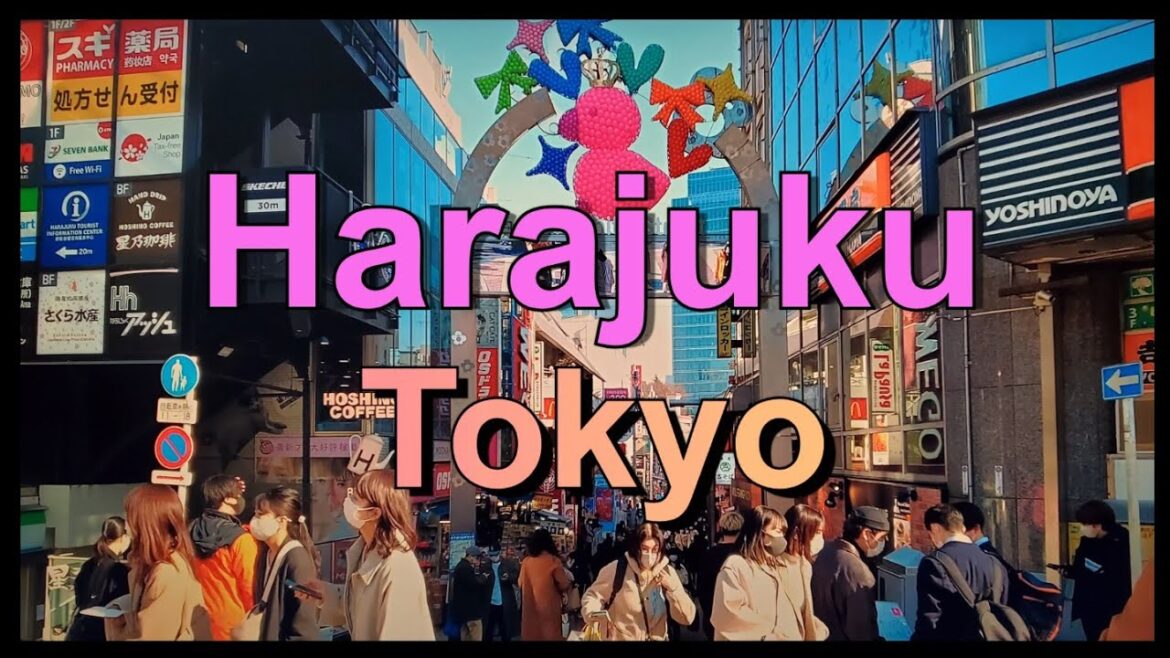【4K】Japan Walk – Tokyo ,Harajuku Is busy today, 原宿 ,February 2021,#Japan #Tokyo #Harajuku#原宿,Takeshita Street 竹下通り
Harajuku (原宿)
Buzzing Harajuku is renowned for colorful street art and youth fashion, with quirky vintage clothing stores and cosplay shops along Takeshita Street, and traditional, upmarket boutiques on leafy Omotesando Avenue. Small, trendy bars fill the surrounding lanes, while dessert shops and carts specialize in sweet crêpes, donuts, and bubble tea. Watari Museum of Contemporary Art hosts cutting-edge temporary exhibitions
About Harajuku
Harajuku (原宿 in Japanese) is a station located between Shibuya and Shinjuku on the JR Yamanote loop line around central Tokyo. Many people get off the train at Harajuku Station to visit such popular spots as Yoyogi Park, Meiji Shrine and Omotesando, a boulevard of luxury brands and other high-end shopping experiences.
Historically, Harajuku was a post town, which is reflected in the kanji characters that make up its name: “meadow lodging.” But today Harajuku has a completely different, and global, appeal as a birthplace of kawaii (cute) culture.
Harajuku is also home to Tokyo’s oldest wooden station building. In June 2020, the area surrounding Harajuku Station was updated with shops and restaurants to become a ‘A New Stage in Tokyo for Global Culture and Creation.’ This trend-setting Tokyo hotspot is well known for its cuisine, shopping and events.
Harajuku station buildingJR Harajuku station sign
From Haneda Airport: 50 minutes by train to Harajuku Station.
From Narita Airport: One hour 40 minutes by train to Harajuku Station.
From Shinjuku Station: Four minutes on the JR Yamanote Line to Harajuku Station.
From Tokyo Station: 26 minutes on the JR Yamanote Line to Harajuku Station.
The epicenter of Japanese anime and ‘kawaii’ culture
Even if you have never been to Harajuku, the name may sound familiar thanks to Gwen Stefani’s pop hit “Harajuku Girls.” In Japan, the area is well-known to just about everyone—particularly fashion-conscious teenagers and young adults. In recent years, Japanese pop singer Kyary Pamyu Pamyu gained international fame for her Harajuku aesthetic and catchy music. Her song “Harajuku Iyahoi,” among many others, was naturally inspired by Harajuku!
Get to know the world-famous Harajuku street fashion
Harajuku styles range from the cute and casual to the extreme. On any given day here, you could run into elegant lolitas in dresses, heavily-pierced goths with long hair, or decora kei enthusiasts wearing colorful wigs. Since Harajuku is the land of free-spirited fashion, you may even run into cosplayers! Though Harajuku’s true heyday of wild fashion may be behind us, there will always be hardcore enthusiasts who carry on Harajuku’s fashion spirit. Why not try dressing up yourself? Whether it’s tops, sweaters, or shirts, visitors can buy all manner of clothing as well as bags, backpacks and other accessories in a range of styles that you aren’t likely to find anywhere else. If you’re looking for a really unique Harajuku experience try a Harajuku makeup or nail salon. Beyond shopping for unique hair clips or changing your hairstyle you might even change your hair color.
Harajuku goth
The area centered on Takeshita Street is a treasure trove of niche fashion. The goth look has been around for many years and is still going strong.
Decked out in all black clothing, the goths of Harajuku form a strong contrast to the colorful ‘kawaii’ looks for which the area is famed. From the vintage-looking gothic lolita to the wild visual-kei goth style, there is a goth subculture for just about any group in Harajuku.
Girl wearing Harajuku goth fashion
Decora kei
Decora kei fashion couldn’t be farther from the monotone goth style—it’s all about being wild, colorful, and over the top. Decora kei enthusiasts prefer to have as many vibrant and over-the-top accessories (especially hair clips) as possible. Keep an eye out for their rainbow-colored wigs and comfy clothing (like hoodies and sweatshirts) reminiscent of old-school cartoons. Decora kei may be less visible on the streets of Tokyo these days but its appeal is still strong around the world. Fairy-kei is a new category of the kawaii decora kei subset, featuring lots of soft, flouncy fabrics and pastel colors.
Girl wearing colorful Decora kei fashion
Harajuku Punk
Harajuku is an evolving ecosystem of global fashion looks, and punk has been a thriving part of that scene for decades. Punk is still represented now, as you will see when you stroll along Takeshita Street.
Ripped band tee shirts, plaid pants, studs, chains, and boots are hallmarks of the Harajuku punk scene. Edgy and anti-conformist!
https://www.gotokyo.org/en/destinations/western-tokyo/harajuku/index.html


20 Comments
Thanks👍👍👍🇰🇬
So nice to see people moving about busier today!
Thank you for this share my friend
素晴らしい!👍
Yeeesss yesss thanks for this one!! Takeshita Dori has changed so much and added new malls since I last went
It's a great start from Tokyu Plaza Harajuku, then into smaller alleys and finally around the station
당신의 걸음 덕분에 c19상황에서 일본여행의 대리만족을 느낄수있습니다. 앞으로도 계속 좋은걸음을 유지해주세요. 응원합니다:)
저는 아키하바라 내부 돌아다니기를 좋아합니다.
What a nice walk man. Really cool shots:)
Harujuka looks busy as all other cities in tokyo are as well but a nice walk around here like always thank you for the tour
Wow its so aesthetic!
Harajuku 👍🏼
一个个人
I wish you could make your video a little bit longer.. Anyway, another cool video from your channel 🤘🏻
Nice view
番号何番?住所調べてやるから、これでも探偵やってるから
18:43
That mall my mom got a purse there.. looking forward to visit after this pandemic.
thanks for these videos …I am so missing my home away from home….
偶然通り過ぎて私のコメントを見たすべての方々は常に幸運が込められた日だけいっぱいになります🥰🥰🥰 いつも 多くの幸せがあなたの元に訪れますように🤗🤗🤗コロナお気をつけて下さい😷🙏🤗健康とご多幸をお祈りします🙏🙏🙏
beautiful town! harajuku!
They are drunken and drug addicted not busy . You're Ridiculous crazy!!!